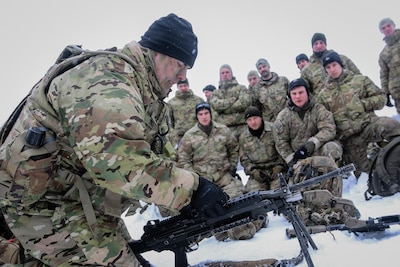By Army Spc. Hubert Delany 22nd Mobile Public Affairs
Detachment
TAPA, Estonia, March 15, 2018 — Among the things that stand
out to many who visit the training area here are the frigid temperatures.
Given this challenge, soldiers with the 82nd Brigade
Engineer Battalion tested their mettle during a series of training events March
6-14.
Making it through these challenges required each soldier to
trust the training they’d completed up to this point in their deployment to
Europe. It also required them to depend on and trust their NATO allies.
Partnership
“This is one of the most tightly knit teams I've seen in my
26 years in the Army,” said Command Sgt. Maj. Paul Vedros, the senior enlisted
member of the 82nd BEB.
Within hours of an order to move to the Baltics, Vedros and
his men packed their gear and moved more than a thousand miles from
Grafenwoehr, Germany, to a location previously unknown to most of them.
“These men have done a terrific job,” said Vedros, while
reminiscing of previous deployments and Army experiences. “It was like watching
an 82nd Airborne Division rapid deployment. Before anybody knew it, these
soldiers were coming to Estonia loaded up and ready to go, and our NATO allies
knew exactly what to do when we sent them."
Upon arrival in Estonia, U.S. troops worked with the
Estonian, British, Canadian, and Danish armies to establish and solidify a
mutually-beneficial training schedule. Among the first training events lined up
for the Americans was cold-water immersion drills with the British Army's 1st
Royal Welsh Battalion. This was followed by other training events with the
Canadian Royal 22nd Regiment and the Danish Guard Hussars Regiment.
The goal for all the training is to build upon
previously-established relations between the U.S. and NATO allies, said Army
Lt. Col. Jesse Curry, the 82nd BEB commander.
Preparedness
Additionally, Curry wanted to ensure that his unit stands
ready to act within a moment’s notice. His unit is in Europe to support
Atlantic Resolve, a U.S. Army Europe effort to deter aggression in the region.
“Our brigade is here to show that we can move and project
power across all of Europe,” Curry said. “When you can take an element from
anywhere in Europe and push them like we have to the most forward point within
NATO, it sends a tremendous message. That we can, and absolutely have the
capability, to defend our NATO allies … and to be lethal if necessary.”
To close out their time in Estonia, the U.S. soldiers
provided chemical, biological, radiological and nuclear defense training to the
Estonian army's 1st Infantry Brigade.
Army Spc. Dewight Young, a CBRN specialist with the 82nd
BEB, participated throughout the weeklong mission and said he believes that
what his fellow soldiers completed in Estonia will have a lasting, positive
impact.
“I’ve never worked with so many people from so many
different countries before, but I am glad we did,” Young said. “It’s not just
Americans, but English, Danish, Estonian and everyone else, working together to
do something good in the world.”






